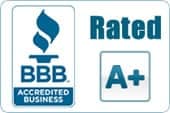Grease traps, and grease interceptors are commonplace in most commercial establishments where food is prepared. The reason is quite simple: food preparation creates a lot of greases and oils that will clog up the sanitary sewer system. Grease traps and interceptors do the job of keeping the bulk of the clog causing materials out of the sewer.
In this article we will discuss a little more about grease traps, and interceptors.
Grease Trap or Grease Interceptor?
The best place to start may be to look at the differences between a trap and an interceptor. While many people (some plumbers included) look at them as being the same, they actually are quite different. They do both perform the same basic function, but how they perform it is where the difference comes in.
The biggest difference between an interceptor and a trap is that, while grease traps are meant to handle a flow of less than 50 gallons per minute (gpm), interceptors are meant to handle much more than that. Interceptors are usually outside, underground, and will service all of the “grease” lines in a particular building. Traps, on the other hand, are much smaller and are meant to handle the waste from a single fixture, or at most, a group of fixtures.
Also, from a design aspect, grease traps almost always have at least 1 “baffle” inside of them to keep the grease from flowing into the outlet line. Grease interceptors, on the other hand, may or may not have an actual baffle. Often they will have an outlet tee, with a pipe that extends to the bottom of the tank. This allows only the “clean” water from the bottom to rise up the outlet and exit into the sewer system.
Maintenance
The most important part of maintaining a grease trap or grease interceptor is knowing when to have it pumped. Since its job is to collect oils and greases, those materials will eventually fill up the holding tank. It is very important to not let the tank completely fill up. As it starts to get too full, it will start to allow the grease into the outlet pipe, and will eventually clog completely.
Another important thing to remember is that grease blocks pipes. While the trap/interceptor will do a good job of keeping most of the grease out of the sewer line, it does not get it all. It also does nothing for the pipe leading to the inlet side of the tank.
To keep backups to a minimum, it is always a good idea to have the inlet lines cleaned periodically. By far, the best way to do this is with a high pressure jetter. Jetters have a knack for getting rid of grease deposits out of your waist lines far more effectively than standard drain cleaning equipment. The best time to do this is directly after getting your trap/interceptor pumped.
While the outlet lines do not see nearly as much grease as the inlet lines, they do get some (as mentioned above), so an occasional jetter flushing of those lines is not a bad idea either. If it is the first time you have jetted the lines, you should get them all done – inlet and outlet. Once you get a maintenance schedule going, you can get by with jetting the outlet lines every other time, or even every third time you get your tanks pumped, depending on the condition of your outlet lines.
Well, that’s about it for this article. Hopefully you were able to get some useful information out of it. If you have more questions about grease traps or grease interceptors, just call Allstar Plumbing. We would be more than happy to help.




